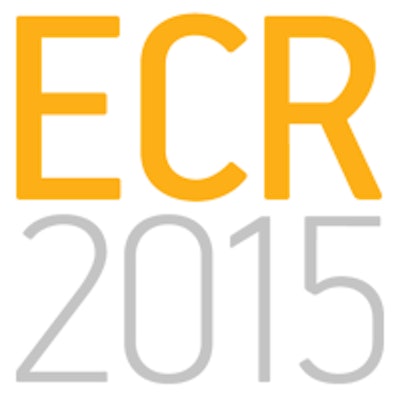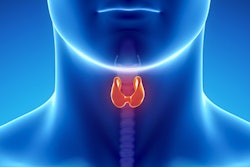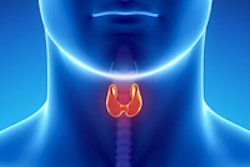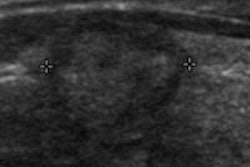
VIENNA - When it comes to characterizing thyroid nodules on ultrasound, the Thyroid Imaging Reporting and Data System (TI-RADS) classification method is the way to go, according to a Friday presentation at ECR 2015.
In comparing TI-RADS with a recently proposed system from Korean researchers, an Egyptian team found that TI-RADS performed similarly to and was more user-friendly than the alternative thyroid ultrasound nodule classification method.
"TI-RADS system is easier and simpler for daily thyroid ultrasound reporting," said presenter Dr. Germeen Ashamallah of Mansoura University in Egypt. "It also gives the surgeon a hint about the next step, such as follow-up biopsy."
In 2011, TI-RADS was proposed as a method for categorizing thyroid nodules on ultrasound and to solve the problem of selecting appropriate nodules to receive fine-needle aspiration (FNA) biopsy, Ashamallah said. Another method was proposed by a Kim et al in 2012; however, that introduced two different categories for classifying solid nodules and partially cystic thyroid nodules (PCTN) based on ultrasound features, she said.
The Egyptian researchers set out to compare the performance of TI-RADS and the thyroid ultrasound classification system regarding reliability, reproducibility, and diagnostic accuracy. They studied 450 patients who underwent thyroid ultrasound. The patients had a mean age of 38.7 ± 15.75 (range of 10-70 years) and included 350 females and 100 males. Thyroid involvement included 350 focal (287 solid nodules, 63 PCTNs), 20 diffuse, and 80 normal cases. The 370 cases with cytopathology results included 220 benign and 150 malignant lesions.
They first classified the thyroid lesions according to TI-RADS: 1 (normal thyroid gland), 2 (benign aspects), 3 (probably benign aspects), 4A (low suspicious aspects), 4B (high suspicious aspects), and 5 (high suspicious aspects). Next, they classified the 350 thyroid nodules as either solid or PCTNs and characterized them using the ultrasound-based classification system into one of the categories of benign, probably benign, borderline, possibly malignant, or malignant. PCTNs were characterized in the same manner, although the borderline category was not used in these lesions.
Each of the classification systems was then independently compared with cytopathology results in the 370 cases in which they were available.
| Sensitivity, specificity, & accuracy | |||
| TI-RADS | Thyroid US classification system (solid nodules) | Thyroid US classification system (PCTN) | |
| 1: 0%/59.9%/49% | Benign: 1.7%/50%/22% | Benign: 8.1%/38.5%/21% | |
| 2: 0%/60.5%/51% | Probably benign: 6.7%/35%/19% | Probably benign: 2.8%/92.3%/40% | |
| 3: 9%/58.8%/47% | Borderline: 2.4%/8.9%/5.2% | N/A | |
| 4A: 25%/65.9%/38% | Possibly malignant: 16%/97%/50% | Possibly malignant: 37.8%/77%/54% | |
| 4B: 60%/70%/69% | Malignant: 73%/97%/83% | Malignant: 51.4%/92%/69% | |
| 5: 100%/86%/89% | |||
| Positive & negative predictive values | ||
| TI-RADS | Thyroid US classification system (solid nodules) | Thyroid U classification system (PCTN) |
| 1: 0%/73% | Benign: 1.2%/28% | Benign: 15%/23% |
| 2: 0%/76% | Probably benign: 12%/22% | Probably benign: 33%/40% |
| 3: 6.7%/66.7% | Borderline: 3.4%/6.4% | N/A |
| 4A: 6.7%/90% | Possibly malignant: 87%/46% | Possibly malignant: 70%/47% |
| 4B: 20%/93% | Malignant: 98%/73% | Malignant: 91%/57% |
| 5: 67%/100% | ||
"Statistical analyses of both systems are nearly the same," she said.
Ashamallah noted that TI-RADS encompasses diffuse thyroid pathologies and focal lesions, while the alternative ultrasound-based diagnostic classification system deals only with thyroid nodules. In addition, TI-RADS deals with thyroid nodules in general terms, while the ultrasound-based classification system places solid nodules and PCTN as separate categories.
The ultrasound-based classification system also has more items to memorize than TI-RADS, Ashamallah said.
As a result, it's easier and more simple to use TI-RADS for daily thyroid ultrasound reporting, she said.




















